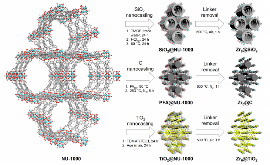Extending the Compositional Range of Nanocasting in the Oxozirconium Cluster-Based Metal–Organic Framework NU-1000—A Comparative Structural Analysis
Abstract
Here, the process of nanocasting in metal-organic frameworks (MOFs) is a versatile approach to modify these porous materials by introducing supporting scaffolds. The nanocast scaffolds can stabilize metal-oxo clusters in MOFs at high temperatures and modulate their chemical environments. Here we demonstrate a range of nanocasting approaches in the MOF NU-1000, which contains hexanuclear oxozirconium clusters (denoted as Zr6 clusters) that are suitable for modification with other metals. We developed methods for introducing SiO2, TiO2, polymeric, and carbon scaffolds into the NU-1000 structure. The responses of NU-1000 towards different scaffold precursors were studied, including the effects on morphology, precursor distribution, and porosity after nanocasting. Upon removal of organic linkers in the MOF by calcination/pyrolysis at 500 °C or above, the Zr6 clusters remained accessible and maintained their Lewis acidity in SiO2 nanocast samples, whereas additional treatment was necessary for Zr6 clusters to become accessible in carbon nanocast samples. Aggregation of Zr6 clusters was largely prevented with SiO2 or carbon scaffolds even after thermal treatment at 500 °C or above. In the case of titania nanocasting, NU- 1000 crystals underwent a pseudomorphic transformation, in which Zr6 clusters reacted with titania to form small oxaggregates of a Zr/Ti mixed oxide with amore »
- Authors:
-
- Univ. of Minnesota, Minneapolis, MN (United States)
- Argonne National Lab. (ANL), Argonne, IL (United States)
- Quantachrome Instruments, Boynton Beach, FL (United States)
- Northwestern Univ., Evanston, IL (United States)
- Northwestern Univ., Evanston, IL (United States); King Abdulaziz Univ., Jeddah (Saudi Arabia)
- Publication Date:
- Research Org.:
- Argonne National Lab. (ANL), Argonne, IL (United States); Energy Frontier Research Centers (EFRC) (United States). Energy Frontier Research Center for Inorganometallic Catalyst Design (ICDC)
- Sponsoring Org.:
- USDOE Office of Science (SC), Basic Energy Sciences (BES)
- OSTI Identifier:
- 1431343
- Grant/Contract Number:
- AC02-06CH11357
- Resource Type:
- Accepted Manuscript
- Journal Name:
- Chemistry of Materials
- Additional Journal Information:
- Journal Volume: 30; Journal Issue: 4; Journal ID: ISSN 0897-4756
- Publisher:
- American Chemical Society (ACS)
- Country of Publication:
- United States
- Language:
- English
- Subject:
- 36 MATERIALS SCIENCE; MOFs; Metal-organic framework; NU-1000; Zr-MOFs; carbon; cluster stabilization; nanocasting; oxozirconium clusters; poly(furfuryl alcohol); silica; titania
Citation Formats
Zhao, Wenyang, Wang, Zhao, Malonzo, Camille D., Webber, Thomas E., Platero-Prats, Ana E., Sotomayor, Francisco, Vermeulen, Nicolaas A., Wang, Timothy C., Hupp, Joseph T., Farha, Omar K., Penn, R. Lee, Chapman, Karena W., Thommes, Matthias, and Stein, Andreas. Extending the Compositional Range of Nanocasting in the Oxozirconium Cluster-Based Metal–Organic Framework NU-1000—A Comparative Structural Analysis. United States: N. p., 2018.
Web. doi:10.1021/acs.chemmater.7b04893.
Zhao, Wenyang, Wang, Zhao, Malonzo, Camille D., Webber, Thomas E., Platero-Prats, Ana E., Sotomayor, Francisco, Vermeulen, Nicolaas A., Wang, Timothy C., Hupp, Joseph T., Farha, Omar K., Penn, R. Lee, Chapman, Karena W., Thommes, Matthias, & Stein, Andreas. Extending the Compositional Range of Nanocasting in the Oxozirconium Cluster-Based Metal–Organic Framework NU-1000—A Comparative Structural Analysis. United States. https://doi.org/10.1021/acs.chemmater.7b04893
Zhao, Wenyang, Wang, Zhao, Malonzo, Camille D., Webber, Thomas E., Platero-Prats, Ana E., Sotomayor, Francisco, Vermeulen, Nicolaas A., Wang, Timothy C., Hupp, Joseph T., Farha, Omar K., Penn, R. Lee, Chapman, Karena W., Thommes, Matthias, and Stein, Andreas. Mon .
"Extending the Compositional Range of Nanocasting in the Oxozirconium Cluster-Based Metal–Organic Framework NU-1000—A Comparative Structural Analysis". United States. https://doi.org/10.1021/acs.chemmater.7b04893. https://www.osti.gov/servlets/purl/1431343.
@article{osti_1431343,
title = {Extending the Compositional Range of Nanocasting in the Oxozirconium Cluster-Based Metal–Organic Framework NU-1000—A Comparative Structural Analysis},
author = {Zhao, Wenyang and Wang, Zhao and Malonzo, Camille D. and Webber, Thomas E. and Platero-Prats, Ana E. and Sotomayor, Francisco and Vermeulen, Nicolaas A. and Wang, Timothy C. and Hupp, Joseph T. and Farha, Omar K. and Penn, R. Lee and Chapman, Karena W. and Thommes, Matthias and Stein, Andreas},
abstractNote = {Here, the process of nanocasting in metal-organic frameworks (MOFs) is a versatile approach to modify these porous materials by introducing supporting scaffolds. The nanocast scaffolds can stabilize metal-oxo clusters in MOFs at high temperatures and modulate their chemical environments. Here we demonstrate a range of nanocasting approaches in the MOF NU-1000, which contains hexanuclear oxozirconium clusters (denoted as Zr6 clusters) that are suitable for modification with other metals. We developed methods for introducing SiO2, TiO2, polymeric, and carbon scaffolds into the NU-1000 structure. The responses of NU-1000 towards different scaffold precursors were studied, including the effects on morphology, precursor distribution, and porosity after nanocasting. Upon removal of organic linkers in the MOF by calcination/pyrolysis at 500 °C or above, the Zr6 clusters remained accessible and maintained their Lewis acidity in SiO2 nanocast samples, whereas additional treatment was necessary for Zr6 clusters to become accessible in carbon nanocast samples. Aggregation of Zr6 clusters was largely prevented with SiO2 or carbon scaffolds even after thermal treatment at 500 °C or above. In the case of titania nanocasting, NU- 1000 crystals underwent a pseudomorphic transformation, in which Zr6 clusters reacted with titania to form small oxaggregates of a Zr/Ti mixed oxide with a local structure resembling that of ZrTi2O6. In conclusion, the ability to maintain high densities of discrete Lewis acidic Zr6 clusters on SiO2 or carbon supports at high temperatures provides a starting point for designing new thermally stable catalysts.},
doi = {10.1021/acs.chemmater.7b04893},
journal = {Chemistry of Materials},
number = 4,
volume = 30,
place = {United States},
year = {Mon Jan 29 00:00:00 EST 2018},
month = {Mon Jan 29 00:00:00 EST 2018}
}
Web of Science
Figures / Tables:
 Figure 1: Schematic showing the concept of nanocasting in the MOF NU-1000.
Figure 1: Schematic showing the concept of nanocasting in the MOF NU-1000.
Figures / Tables found in this record:

 Search WorldCat to find libraries that may hold this journal
Search WorldCat to find libraries that may hold this journal